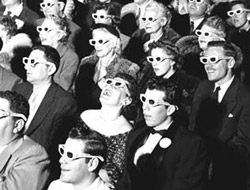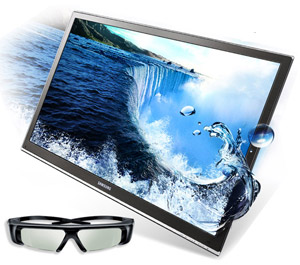Question:
Dear Big Picture Big Sound,
I've been hearing and reading a lot about 3D TV in the papers and on my plain old flat (2D) TV. Do you still need those red and blue paper glasses to watch 3D TV? Because those are uncomfortable and I don't want to wear them all the time. And what is there to watch in 3-d anyway?
Thanks,
-Dimensionally Challenged in DC
Answer:
Dear Mr. (or Ms.) Challenged,
This is the year of must-see 3D, so it's a pretty hot topic. More movies are starting to pop up (and out) in 3D. Films like Avatar and Alice in Wonderland are blowing up box-office receipts and actually getting people to go back to theaters again.
Of course, many readers prefer the comfort of their couch for the movie experience, and that's ok, too. This will be their year, the year that 3DTV will hit the mainstream -- and maybe even your living room.

First, you should know that 3D has been around since before your grandma was born. Also, there are actually four types of 3D technology: Anaglyphic 3D, Polarization 3D, Alternate Image, and Autostereoscopic. The first three all need some type of glasses; Autostereoscopic does not, but it's not that well developed yet, nor available in consumer products. So the short answer is: YES, you do still need glasses -- but they're a lot better than those old paper things!
A Clear Vision of 3D
Anaglyphic 3D uses two images, which are offset but presented simultaneously on the screen, to create 3D. The glasses have two different colored lenses. Normally one lens is red and one is cyan, though there are some variations. If you've seen pictures from the '50s of people staring at big-screen 3D images with paper colored glasses, you've seen people staring at Anaglyphic 3D. Many DVD and Blu-ray releases have used this format. And if you haven't noticed, it's not all that pretty. Colors are a little off and some the images can be fuzzy. Also, those paper glasses can be itchy and cause headaches after prolonged use.
Polarization 3D displays images on the screen with the light polarized in different directions for each eye. Matching passive polarized glasses separate the right and left eye images on the screen, so your brain can combine them into a single 3D image. Polarization is typically used in projection systems with a dedicated projector used for each eye however new less expensive digital projection systems have been developed which can project both left and and right eye images from a single projector by alternativing the images very quickly on screen. This has lowered the cost of entry for movie theaters and has helped usher along a new resurgence of interest in 3D movies.
Alternate-frame sequencing uses a single strip of film (or a single data stream in the case of digital media), alternating images for the left and right eyes in very fast succession. To allow your left and right eyes to see the correct half of the 3D image, alternate frame sequencing 3D uses uses battery-powered glasses with active shutters that open and close in rapid succession -- typically 60 times per second per eye for consumer gear in the US. Again, your brain is able to take these two different images and put together a single 3D image much the same way that it does in real life. Both Polarization and Alternate Frame Sequencing 3D are used in mainstream 3D presentations, at the theater and even at some theme parks.
Autostereoscopic 3D does not use 3D glasses, however it's also not available for your home. It's more for advertising purposes, is currently limited in its viewing range and applications and is prohibitively expensive, so don't torture yourself about that. For now, 3D at home does require glasses, but it's so much better than the old anaglyph technology that it really must be seen to be believed.
3D@Home
Like 3D technology in general, 3D TV in the home has been through its changes. Aside from the paper glasses and anaglyph images on your normal TV, manufacturers have actually been producing 3D HDTVs for a while now. In 2007, both Samsung and Mitsubishi came out with their own 3D-enabled DLP high-def TVs. Both would display PC content, via an external transmitter box and LCD shutter glasses.


Hope that helps! You can also get yourself to a Sony Style store or a Best Buy (one with a Magnolia Home Theater department) to check out some of these new Full HD 3D HDTVs in person. A few Sony and Samsung models can be ordered already online. The Panasonic Full HD 3DTVs are currently only available in Best Buy stores, and will be making their way to other Brick & Mortar stores later this spring.
Get Yourself Some Gear:
Also Check Out: